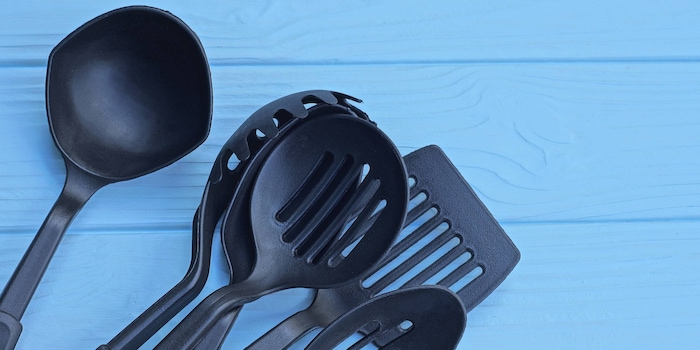
News + Trends
But no recycled electronic waste in spatulas? That's what an expert says
by Anna Sandner

A study shows that in the USA many everyday products made of black plastic contain toxic flame retardants. These harmful chemicals presumably come from recycled electronic waste. This is how you can avoid health risks from black plastic.
This article was edited on 16 January 2025 and updated with current information.
Do you use cooking utensils made of plastic? Then hopefully they're not from the USA, otherwise you could be unintentionally stirring toxins into your food. A recent study by US-American and Dutch researchers has shown many black, plastic household utensils contain substances that shouldn’t be there. What does this mean for you and your kitchen? The study has answers.
The results of the products from the USA don't correspond with Europe due to different recycling regulations and specifications for the use of recycled materials. Stiftung Warentest bought and tested 26 spatulas in Germany and found no harmful bromine. You can find out more here:
A team from the Netherlands and the USA tested 203 black plastic products, including kitchen utensils, hair accessories and toys. The worrying result? 85 per cent of the products analysed contained toxic flame retardants. The concentrations were as high as 22,800 milligrammes per kilogram – a considerable amount that exceeds the EU limit in consumer products by a mile. However, the products examined all came from the USA.
The researchers suspect that the toxins come from recycled electronic waste. Many electronic devices contain flame retardants in their plastic casing. When these appliances aren’t recycled correctly, the toxic chemicals can end up in new products – even those that don’t need flame retardants.
Black plastic is particularly common because it’s often made from recycled electronic cases. The dark colour makes it easier to mix different plastics without any noticeable colour differences. Plus, during recycling, dyes are often added to achieve a uniform black colour. This makes it even more difficult to detect contaminated material.
Flame retardants are the focus of health research, as they are associated with various health risks. The International Agency for Research on Cancer (IARC) has classified some flame retardants with bromine as potentially carcinogenic. In addition, studies suggest that these chemicals can affect hormone balance, especially the thyroid. The possible effects on children are particularly worrying. Researchers have established links between exposure to flame retardants and developmental disorders in adolescents. Animal testing indicates that reproductive capacity could also be affected. Certain flame retardants could have a negative impact on both fertility and foetal development.
So there’s plenty of evidence to justify us banishing these potential poison spreaders from our households. This is because kitchen utensils in particular can transfer harmful substances into the food during cooking. However, there’s no reason to panic here. In Europe, both stricter recycling requirements and stricter regulations apply to materials that come into contact with food.
The good news is that there are several ways to reduce your exposure to these toxins. Avoid black plastic products. The study only showed that black plastics in American products are particularly affected. However, to be on the safe side, go for light colours, as the likelihood of encountering recycled electronic waste is lower. Use alternative materials: stainless steel or wood are good alternatives for kitchen utensils. Stainless steel is durable, easy to clean and doesn’t release harmful chemicals. Wood has natural antibacterial properties and is very durable with proper care.
Pay attention to quality. Buy products from reputable manufacturers who can prove the safety of their products. Some companies are committed to banning harmful flame retardants from their products.
Researchers are calling for stricter regulations and more transparency in the supply chain. They stress that dangerous flame retardant additives should be eliminated and replaced with safer materials. They’re also calling for better supervision of the recycling process to stop toxic substances ending up in everyday products.
Science editor and biologist. I love animals and am fascinated by plants, their abilities and everything you can do with them. That's why my favourite place is always the outdoors - somewhere in nature, preferably in my wild garden.
Practical solutions for everyday problems with technology, household hacks and much more.
Show all